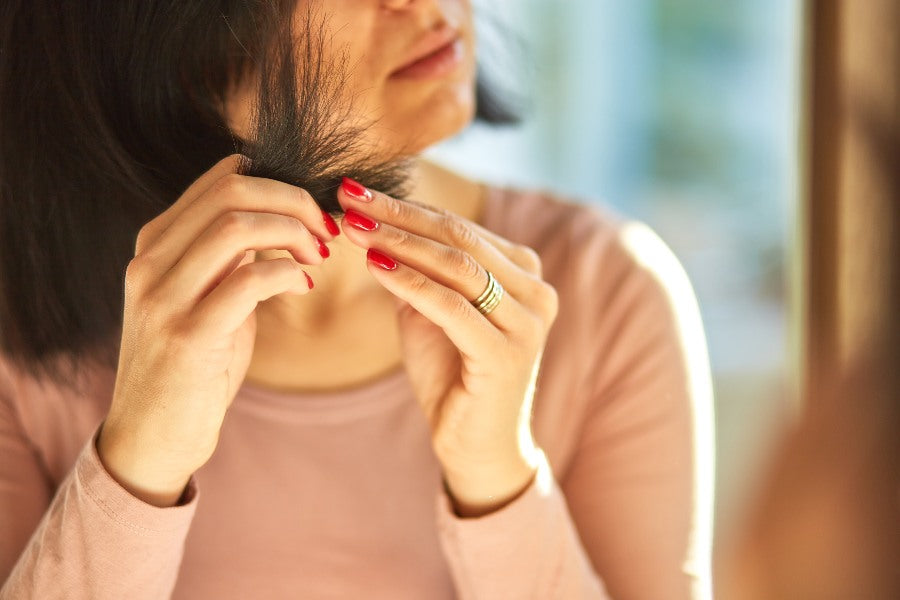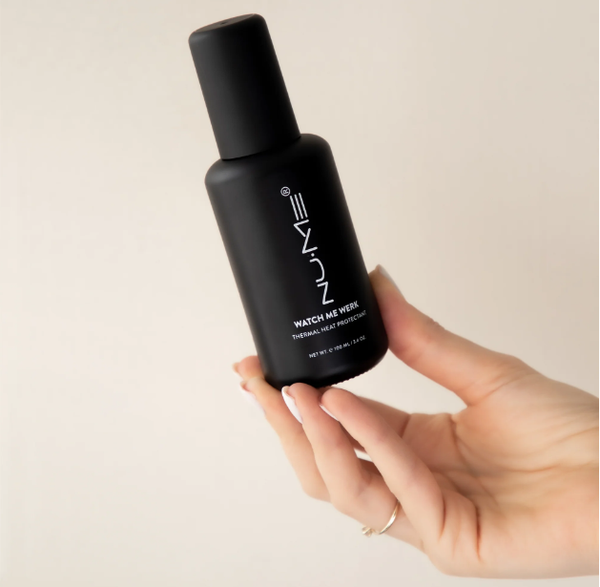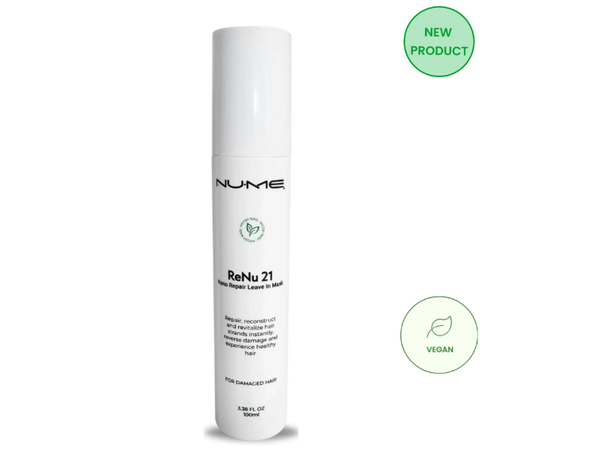Cuando se trata de peinar tu cabello con calor, ¿450 grados son demasiado calientes para el cabello? Echa un vistazo a lo que sucede cuando te rizas o alisas el cabello a altas temperaturas.
Si te encanta el peinado térmico tanto como a nosotros , probablemente te hayas preguntado si lo estás haciendo a la temperatura adecuada para evitar daños en tu cabello relacionados con el calor .
Preguntas como "¿450 grados son demasiado calientes para el cabello?" son comunes y por supuesto, completamente razonables.
En este artículo, responderemos a tus preguntas más frecuentes sobre el peinado con calor y las temperaturas para asegurarnos de no dañar tu hermosa melena.
Entonces, sin más preámbulos, vayamos directo al asunto:
¿450 grados son demasiado calientes para el cabello?
Sí, 450 grados Fahrenheit (230 grados Celsius) generalmente se consideran demasiado calientes para un peinado con calor térmico. Las altas temperaturas pueden ser perjudiciales para el cabello si no se toman las medidas adecuadas porque pueden provocar daños en las proteínas, pérdida de humedad, daños en las cutículas y cambios estructurales.
Lo bueno es que hay algunas cosas que puedes hacer para mitigar el daño y minimizar el riesgo, como usar una plancha con revestimiento de turmalina , aplicar un protector térmico y usar tu herramienta de peinado con calor a temperaturas más bajas siempre que sea posible. ¡Pero hablaremos de eso más adelante!

¿Cómo daña el calor el cabello?
El calor daña el cabello al desnaturalizar su estructura proteica (queratina), dejándolo débil y quebradizo. Las altas temperaturas también pueden provocar la pérdida de humedad, lo que provoca sequedad y reducción de la elasticidad. Además, la capa exterior de la cutícula puede levantarse, provocando frizz y exponiendo las capas interiores a daños.
Cuando te peinas el cabello a 450 grados y otras temperaturas altas, suceden algunas cosas que pueden dañar la salud general de tu melena. Ahora que tiene la respuesta corta, echemos un vistazo más profundo:
- Daño proteico : el cabello se compone principalmente de una proteína llamada queratina . El calor excesivo puede descomponer la estructura proteica, provocando que el cabello se debilite y dañe.
- Pérdida de humedad : las altas temperaturas pueden quitar la humedad natural del cabello. Esto lo hace más propenso a la sequedad, el frizz y una falta general de brillo. La pérdida de humedad también puede afectar la elasticidad del cabello, haciéndolo más susceptible a la rotura.
- Daño a la cutícula : la capa externa del tallo del cabello, llamada cutícula, juega un papel crucial en la protección de las capas internas. Las altas temperaturas pueden hacer que la cutícula se levante, exponiendo las delicadas capas internas del cabello a daños ambientales y una mayor pérdida de humedad.
- Cambios estructurales : la exposición prolongada a altas temperaturas puede provocar cambios en la estructura del tallo del cabello. Esto puede manifestarse como puntas abiertas, fragilidad y una disminución general en la capacidad del cabello para resistir el estrés y el peinado.
- Decoloración del color : para las personas con cabello teñido, las altas temperaturas pueden acelerar la decoloración. El calor abre la cutícula del cabello, permitiendo que las moléculas de color escapen más fácilmente.
¿Cuánto dura el daño por calor?
La duración del daño por calor varía según la gravedad del daño y el tiempo que pasó sin abordarlo. Por ejemplo, los daños menores como la sequedad o el frizz se pueden mejorar con el cuidado adecuado.
Por otro lado, los daños más graves, incluidas las roturas y las puntas abiertas, son irreversibles y requieren recortes.
Por este motivo, recomendamos ampliamente tomar medidas preventivas, así como brindarle el cuidado adecuado a tu cabello para mantener su salud a largo plazo.
¿Cómo puedo prevenir el daño por calor ?
Si quieres conocer todos los detalles en función de los objetivos que tienes con tu peinado térmico, te recomendamos los siguientes artículos:
- 10 consejos rápidos para alisar tu cabello sin dañarlo
- 7 consejos sobre cómo rizar el cabello sin dañarlo
De lo contrario, aquí tienes algunos de nuestros consejos más importantes:
1. Invierte en una plancha o un rizador con placas de turmalina.
Las herramientas de peinado con calor hechas con la piedra preciosa turmalina pueden ayudar a prevenir el daño por calor debido a su capacidad de producir iones negativos (gracias al mineral).
Estos iones ayudan a sellar la cutícula del cabello, reduciendo el encrespamiento y reteniendo la humedad; la falta de humedad, como acabamos de ver, es una de las principales formas en que se daña el cabello cuando se peina a altas temperaturas.
Además, las placas con infusión de turmalina promueven un deslizamiento más suave, lo que reduce la necesidad de realizar múltiples pasadas y disminuye aún más la exposición al calor.
Recomendamos la plancha alisadora NuMe Megastar y el rizador automático NuMe si buscas obtener resultados sin esfuerzo y sin daños.
2. Aplicar un protector térmico antes de peinar.
Aplicar un protector térmico antes del peinado es imprescindible si buscas minimizar el daño causado por las altas temperaturas. Entonces, ahora que sabes que 450 grados es demasiado caliente para peinar el cabello, ten en cuenta que este paso será fundamental.
Los protectores térmicos forman una barrera en el tallo del cabello, protegiéndolo del impacto directo de las altas temperaturas durante el peinado. Actúan como una capa protectora, evitando la pérdida excesiva de humedad y el daño de las proteínas.
Al crear esta barrera, los protectores térmicos reducen el riesgo de estrés térmico en el cabello, minimizando la sequedad, la fragilidad y las puntas abiertas. Recomendamos el protector térmico térmico NuMe Watch Me Werk para obtener resultados óptimos.
3. Evite el peinado con calor excesivo
Si busca minimizar el daño por calor, limite el peinado con calor a 1 o 2 veces por semana. Darle descansos al cabello entre sesiones de peinado le dará tiempo para recuperarse y mitigar los riesgos.
Esto se debe a que la exposición prolongada y excesivamente frecuente al calor puede dañar la capa protectora de la cutícula, provocando que el cabello se vuelva débil, opaco y encrespado. ¡Deshacerse del cabello encrespado , especialmente si es causado por daño por calor, puede ser un desafío!
Además, el peinado frecuente con calor también suele provocar puntas abiertas, lo que puede hacer que el cabello luzca poco saludable y obstaculizar su crecimiento .
4. Opta por temperaturas más bajas siempre que sea posible
Ya sabemos que 450 grados es demasiado calor para el cabello, pero a veces, dependiendo del tipo y la textura de tu cabello, puede ser una buena temperatura para lograr resultados óptimos. Esto es especialmente cierto si tienes el cabello grueso y rizado.
Sin embargo, si no es necesario, optar por temperaturas más bajas siempre que sea posible puede ser una buena forma de evitar daños innecesarios a tu cabello. Por ejemplo, si tienes el cabello fino o tratado químicamente, puedes obtener buenos resultados con tan solo 200 °C (200 °F).
Por esta razón, es esencial invertir en una plancha con ajustes de control de temperatura como la galardonada plancha NuMe Megastar . Esto le permitirá tener más control sobre su peinado con calor y minimizar el daño como resultado.
Puede leer más sobre las mejores temperaturas para el peinado con calor térmico aquí .
5. Incorporar tratamientos de acondicionamiento profundo
Otra forma de mitigar el daño causado por el peinado con calor es incorporar un tratamiento de acondicionamiento profundo a su rutina de cuidado del cabello . Los tratamientos de acondicionamiento profundo proporcionan hidratación y nutrición intensas a tu cabello, ayudando a contrarrestar la sequedad causada por el peinado con calor.
A menudo contienen ingredientes como aceites hidratantes, proteínas y vitaminas que penetran en el tallo del cabello, restaurando la humedad y fortaleciendo la estructura proteica.
Esta hidratación y fortificación adicionales hacen que su cabello sea más resistente a los efectos dañinos del calor, lo que reduce el riesgo de fragilidad, rotura y puntas abiertas.
El acondicionamiento profundo regular puede mejorar la salud general del cabello , haciéndolo más resistente al estrés del peinado con calor y promoviendo una apariencia más suave y brillante.
Recomendamos la mascarilla capilar de turmalina vegana NuMe para obtener resultados óptimos con su tratamiento de acondicionamiento profundo. Con una infusión de turmalina en polvo, aceite de argán y manteca de parkii, esta mascarilla para el cabello elaborada con ingredientes totalmente naturales mejora la elasticidad y la flexibilidad sin salir de casa.
6. Evita planchar el cabello mojado
Uno de los mayores errores que solemos ver cuando se trata de peinado con calor térmico es planchar el cabello mojado . Sí, sabemos que la vida es corta y estás constantemente en movimiento, pero no ignores el daño que puede causar no tomarte el tiempo de secar tu cabello primero después del lavado.
Si aún no está convencido, echemos un vistazo más profundo:
- Daño al cabello : el cabello está en su estado más vulnerable cuando está mojado, lo que significa que las altas temperaturas pueden causar daños severos a la estructura del cabello, como daño a la cutícula y alteración de la corteza. El peinado con calor sobre el cabello mojado también puede provocar la pérdida de humedad, que es esencial para la flexibilidad y la fuerza del cabello.
- Daño por vapor : otra cosa a tener en cuenta cuando se trata de peinar el cabello mojado con calor es el daño por vapor. ¿Entonces, qué significa esto exactamente? Bueno, el calor convierte el agua del cabello mojado en vapor, lo que puede provocar que las cutículas del cabello se agrieten, provocando que el cabello se vuelva quebradizo, encrespado y dañado.
- Mayor rotura : debido a su mayor vulnerabilidad y elasticidad en estado húmedo, el cabello tiende a ser más propenso a romperse. Aplicarle mucho calor puede provocar una rotura excesiva y puntas abiertas, ¡y estamos seguros de que eso no es lo que quieres para tu cabello!
Además del daño, planchar el cabello mojado generalmente puede ser más ineficaz cuando se trata de peinar, y es posible que no te guste el resultado final de tus esfuerzos (¡habla de "ahorrar tiempo!"). También corre el riesgo de quemarse el cuero cabelludo o las manos, lo cual no debe subestimarse.
Entonces, ¿todavía te preguntas si 450 grados es demasiado caliente para el cabello?
7. Utiliza una mascarilla reparadora
Si está buscando aprovechar los beneficios del peinado con calor térmico sin dañarlo , le recomendamos encarecidamente utilizar una mascarilla reparadora , como la mascarilla sin aclarado NuMe ReNu21 Nano Repair .
Formulada con 21 aminoácidos, esta increíble mascarilla ayuda a reconstruir el cabello dañado y reconectar los enlaces rotos imitando la estructura del cabello. El resultado son mechones de cabello brillantes, florecientes y relucientes: los resultados son casi instantáneos y su cabello mejorará con cada uso.
Preguntas más frecuentes
¿Se pueden reparar los daños causados por el calor?
Los daños menores por calor, como la sequedad, se pueden mejorar con un acondicionamiento profundo y un cuidado adecuado. Sin embargo, los daños graves, como las puntas abiertas, son irreversibles y requieren recortes.
Las prácticas saludables constantes ayudan a la recuperación, pero la prevención sigue siendo crucial para la salud del cabello a largo plazo.
¿Cómo sé si tengo daño por calor?
Los signos de daño por calor incluyen sequedad, frizz, puntas abiertas y textura quebradiza. El cabello puede carecer de elasticidad y brillo. Si tus mechones se rompen con facilidad o no rebotan cuando se estiran, es probable que esté dañado.
El acondicionamiento y el recorte profundos regulares pueden ayudar a recuperar la salud y la manejabilidad.
¿Puedo recuperar mis rizos después del daño causado por el calor?
Sí, puedes recuperar tus rizos después del daño causado por el calor. Recorta las puntas dañadas, concéntrate en un acondicionamiento profundo para restaurar la humedad y evita el peinado con calor. Adopte los rizos naturales y utilice técnicas de peinado como giros o trenzas para mejorar el patrón de los rizos.
La paciencia y el cuidado constante ayudarán a revivir tus rizos con el tiempo.
¿400 grados son demasiado calientes para el cabello rizado?
Sí, 400 grados es demasiado calor para el cabello rizado. El cabello rizado es más propenso a la sequedad y al daño. Limítese a temperaturas más bajas siempre que sea posible, alrededor de 300 a 350 grados, para peinar sin causar daño.
Utilice un protector térmico y priorice la salud de sus rizos para evitar daños por calor excesivo.
¿300 grados son demasiado calientes para el cabello?
No, 300 grados generalmente son seguros para el cabello, pero use un protector térmico. Es una temperatura moderada que permite un peinado eficaz minimizando el riesgo de daños. Ajusta según tu tipo y condición de cabello, y prioriza siempre la protección y el cuidado.
¿Puede el calor dañar el cabello fino?
Sí, el calor puede dañar el cabello fino. El cabello fino es más vulnerable y el calor excesivo puede provocar rotura, sequedad y reducción de volumen. Utilice temperaturas más bajas, utilice protectores contra el calor y evite peinarlos con frecuencia para proteger el cabello fino de posibles daños.





Compartir:
Los 7 principales beneficios de los productos capilares veganos para cabello rizado
Los 8 mejores ingredientes para el cabello encrespado: qué buscar en el cuidado del cabello